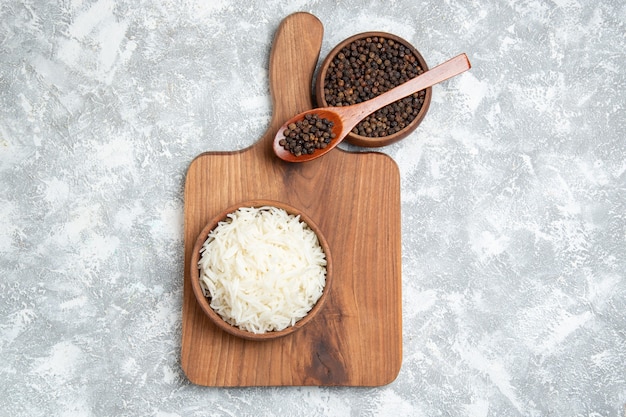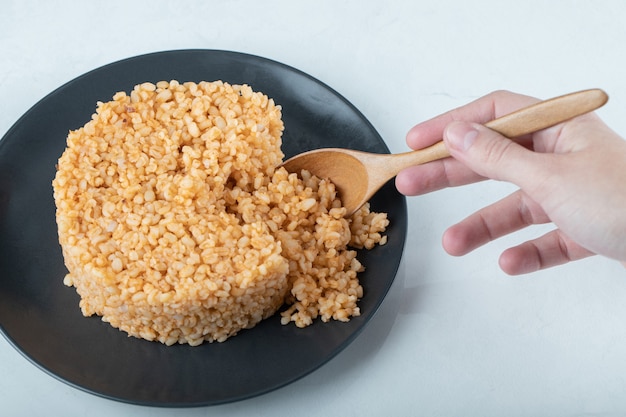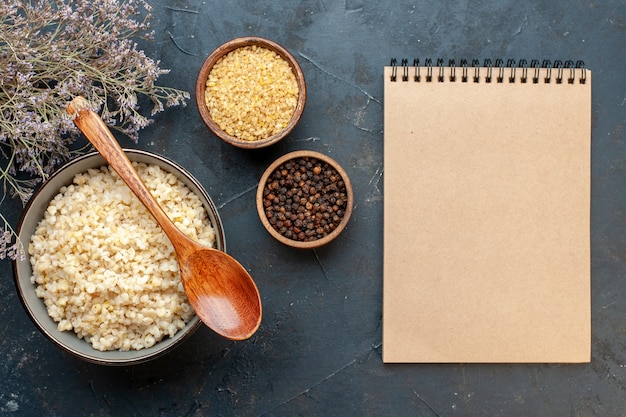We've all been there, haven't we? You're excited to whip up a healthy and delicious meal featuring brown rice, but then the dreaded question pops up: "Will it be fluffy and perfect, or will it be a sticky, mushy mess?" It's enough to make you want to stick to the white stuff, but don't you worry, I'm here to help you master the art of perfect brown rice, every single time.
I've been on this brown rice journey for years, trying different methods, reading countless recipes, and experimenting with various ratios. I've had my fair share of rice disasters (let's not talk about that time I turned it into porridge!), but finally, after countless trials and errors, I cracked the code. And now, I'm sharing my secrets with you, my dear reader. Grab your favourite saucepan, a measuring cup, and get ready to unlock the secrets of fluffy, delicious brown rice.
Part 1: choosing the right rice

The Case for Brown Rice
Before we dive into the cooking process, let's talk about why brown rice is worth the effort. First off, it's a nutritional powerhouse, packed with fibre, magnesium, and manganese. It's also a great source of protein and complex carbohydrates, which can help you feel fuller for longer. Plus, it has a lovely nutty flavour that adds a delicious dimension to any meal. It's a true win-win!
types of brown rice: A Variety for Every Taste
You're probably aware there's more than one type of brown rice out there, each with its own unique character. Let's explore a few of the most popular options:
- long-grain brown rice: The classic choice, known for its fluffy texture and distinct nutty flavour. It’s incredibly versatile, working well in salads, stir-fries, or even as a simple side dish.
- medium-grain brown rice: This rice has a slightly chewier texture than long-grain, making it a great option for dishes like sushi or pilafs.
- short-grain brown rice: This rice is known for being sticky and a bit harder to cook, but it's a common choice in Asian cuisine where its texture and stickiness are prized.
- wild rice: Not technically rice but a type of aquatic grass, wild rice is known for its chewy texture and slightly earthy flavour. It’s often used in salads or as a side dish.
Choosing the right rice depends on your personal preferences and the dish you’re making. I usually opt for long-grain brown rice because it’s versatile and easy to cook, but feel free to explore and find your favourite!
Part 2: The Right Tools for the Job

You don’t need a fancy kitchen to cook perfect brown rice, but having a few specific tools will make the process much easier and smoother. Trust me, it's worth investing in these essentials:
A Reliable Saucepan: Your Rice-Cooking Companion
A sturdy saucepan with a lid is your go-to for cooking rice. I recommend a saucepan with a thick base that distributes heat evenly. This helps prevent the rice from sticking to the bottom and ensures that every grain cooks perfectly.
A Precise Measuring Cup: The Key to Perfect Proportions
Getting the water-to-rice ratio right is crucial for perfect results. A measuring cup will help you get those quantities spot-on every time. I use a liquid measuring cup with a spout for added accuracy.
A Fork or Wooden Spoon: Fluffing Up Your Rice
You’ll need a fork or wooden spoon to fluff the rice after it's cooked. This helps separate the grains and prevent them from clumping together, resulting in a fluffy and airy texture. You can even use your fingers if you prefer, but I find a fork is a bit more hygienic!
Part 3: The Magic Formula: Ratio and Timing

The secret to perfect brown rice lies in understanding the ideal water-to-rice ratio and the perfect cooking time. I've found that a 2:1 ratio works best for consistently great results. For every 1 cup of rice, use 2 cups of water.
The Perfect Ratio: A Simple Guide
Here’s a table to help you visualize this ratio:
| Rice (cups) | Water (cups) |
|---|---|
| 1 | 2 |
| 2 | 4 |
| 3 | 6 |
Feel free to adjust the quantities based on how much rice you need. Just remember to stick to the 2:1 ratio for the best results.
Cooking Time: It's All About Preference
The cooking time for brown rice can vary depending on the type of rice you're using and your desired level of doneness. Generally, long-grain brown rice takes about 45 minutes to cook. You can check for doneness by poking a grain with a fork. If the centre is soft and there’s no more visible water in the pot, it's ready. But remember, everyone has different taste preferences, so don’t be afraid to adjust the cooking time to suit your liking.
Part 4: The Step-by-Step Guide to Perfect Brown Rice
Now, let's get our hands dirty and actually cook the rice! This step-by-step guide will walk you through the process, ensuring you achieve perfect brown rice every time.
Step 1: Rinsing the Rice: A Clean Start
Start by rinsing the rice thoroughly under cold running water. This helps remove excess starch, preventing the rice from becoming sticky and ensuring fluffy, separate grains. Pour the rice into a fine-mesh sieve and rinse it until the water runs clear. You’ll be amazed at how much of the cloudy starch comes out!
Step 2: Bringing the Water to a Boil: Setting the Stage
Add the rinsed rice and water to your saucepan. Bring the mixture to a rolling boil over medium-high heat. This initial boil helps the rice cook evenly and ensures that the grains are properly heated through. You’ll see the water start to bubble vigorously. You can also add a pinch of salt at this stage if you like.
Step 3: Reducing Heat and Simmering: Time for Patience
Once the water boils, reduce the heat to low, cover the pot with a tight-fitting lid, and simmer for 45 minutes. During this time, resist the urge to peek at the rice! You want to create a steamy environment, which helps the rice cook evenly. Just let it do its thing. You can use this time to catch up on some emails, make a salad, or even relax and enjoy a cup of tea.
Step 4: Resting the Rice: The Final Touch
After 45 minutes, turn off the heat and let the rice rest, covered, for 10-15 minutes. This allows the rice to absorb any remaining water and steam, resulting in perfectly cooked grains. This resting period is crucial for achieving that fluffy, tender texture.
Step 5: Fluffing the Rice: The Finishing Touch
Using a fork or a wooden spoon, gently fluff the rice to separate the grains. This prevents the rice from clumping together and gives it a light, airy texture. Now, your perfect brown rice is ready to be devoured! You can also sprinkle a few tablespoons of water over the rice, cover it with a tea towel, and then a lid for about 5-10 minutes if you prefer extra soft rice.
Part 5: Tips and Tricks for fluffy brown rice: Elevate Your Rice Game
Over the years, I've picked up some helpful tips and tricks that can help you achieve the perfect brown rice. Here are a few of my favourites:
Don’t Overcook It: Avoiding Mushy Rice
Brown rice can go from fluffy to mushy in a matter of minutes. Keep a close eye on the cooking time and don’t be afraid to undercook it slightly, as it will continue to cook while resting. Overcooked rice will be sticky and unpleasant.
Don’t Stir: Letting the Rice Do Its Thing
It’s tempting to stir the rice during cooking, but resist the urge! Stirring can break the rice grains and prevent them from cooking evenly. Just leave it to simmer undisturbed. If you’re worried about the rice sticking, give the pot a gentle shake from time to time.
Use a Tight-fitting Lid: Trapping the Steam
A tight-fitting lid is crucial for creating a steamy environment that cooks the rice evenly. If your lid doesn't seal tightly, try placing a tea towel between the lid and the pot to prevent steam from escaping.
Experiment with Flavours: A Burst of Taste
Don't be afraid to add a dash of creativity to your brown rice. You can add flavour by incorporating ingredients like herbs, spices, or even a squeeze of lemon juice. Experiment with different flavour combinations to find your favourites. My personal favourite is to add a bay leaf while cooking for a subtle flavour boost.
Part 6: Beyond the Basics: Mastering Brown rice variations
Now that you’ve mastered the basic method, let's explore some exciting variations to elevate your brown rice game.
Brown rice pilaf: A Flavourful Twist
A pilaf is a dish made with rice cooked in broth or stock. It's a delicious way to add flavour and depth to your rice. Simply replace the water with broth or stock, add some chopped vegetables and herbs, and let it simmer until the liquid is absorbed. You can use chicken, vegetable, or beef broth, depending on your preference. Experiment with different herbs and spices to create your own signature pilaf.
brown rice salad: A Healthy and Refreshing Meal
Brown rice makes a fantastic base for a healthy and flavourful salad. Cook the rice according to the instructions, let it cool completely, then toss it with your favourite vegetables, herbs, and dressing. This is a great option for a light lunch or dinner. Consider adding grilled chicken or tofu for extra protein.
brown rice soup: Comforting and Hearty
You can use cooked brown rice to add texture and heartiness to your favourite soups. Add it to the soup at the end of cooking and simmer for a few minutes to allow the rice to absorb the flavours. This is perfect for a comforting and filling meal on a chilly day. Try adding brown rice to your favourite lentil soup or vegetable soup for extra flavour and texture.
Part 7: Storing and Reheating Brown Rice: Preserving Perfection
Once you’ve cooked a batch of perfect brown rice, it's important to store it correctly to maintain its flavour and texture. And don’t worry, you can definitely reheat it without compromising the deliciousness.
Storing Brown Rice: Keeping It Fresh
Let the cooked rice cool completely before transferring it to an airtight container. Store it in the refrigerator for up to 3 days. You can also freeze cooked brown rice for up to 3 months. To freeze, place the rice in a freezer-safe container or bag and freeze it flat. Frozen rice is great for adding to soups, stews, or stir-fries.
Reheating Brown Rice: Restoring Its Goodness
To reheat brown rice, you can use the microwave, stovetop, or oven. For microwave reheating, add a tablespoon or two of water to the rice and microwave on high for 1-2 minutes, stirring halfway through. For stovetop reheating, add the rice to a saucepan with a little water or broth and heat over low heat until warmed through. For oven reheating, spread the rice on a baking sheet and bake at 350°F (175°C) for 10-15 minutes, until heated through.
Part 8: FAQs: Answering Your Brown Rice Questions
I’ve been there, I know you have questions. Here are some of the most frequently asked questions about cooking brown rice, along with my expert answers.
1. Can I use tap water to cook brown rice?
While it's generally fine to use tap water, I prefer using filtered water because it doesn’t contain chlorine and other impurities. This can enhance the taste and flavour of the rice. But, if filtered water isn’t readily available, tap water is a perfectly acceptable alternative.
2. What if the rice is still crunchy after 45 minutes?
Don’t worry! This is totally normal. Just add a bit more water, cover the pot again, and let it simmer for a few more minutes. You can check the rice every 5 minutes or so until it’s cooked to your liking. You can also try adding a tablespoon or two of water, cover the pot, and let it steam for an extra 5-10 minutes.
3. Can I cook brown rice with other grains?
Absolutely! Experiment with different combinations like quinoa, barley, or farro. Just be sure to adjust the cooking time based on the other grains you’re using. You can even add lentils, chickpeas, or beans for a hearty and protein-packed meal.
4. How do I make brown rice taste better?
As mentioned earlier, you can experiment with herbs, spices, and other flavourings. A bay leaf, a pinch of turmeric, a squeeze of lemon juice, or even some chopped herbs can enhance the flavour. You can also try adding a splash of broth or stock to the cooking water for extra flavour.
5. What are some ideas for dishes using cooked brown rice?
Cooked brown rice is incredibly versatile and can be used in a wide range of dishes. Here are just a few ideas to get you started:
- Salads: Toss cooked brown rice with your favourite vegetables, herbs, and dressing for a healthy and flavorful salad. Try adding grilled chicken, tofu, or chickpeas for extra protein.
- stuffed peppers: Use cooked brown rice as a base for filling bell peppers with your favourite vegetables and cheese. Get creative with different vegetable combinations and experiment with different cheeses.
- Sushi Bowls: Build your own sushi bowls with cooked brown rice, avocado, cucumber, salmon, and your favourite sauces. Don’t be afraid to add other vegetables like carrots or edamame.
- Burrito Bowls: Create delicious burrito bowls with cooked brown rice, black beans, salsa, avocado, and your favourite toppings. Try adding corn, cilantro, and a squeeze of lime for extra flavour.
- rice pudding: Combine cooked brown rice with milk, sugar, and spices to create a comforting and creamy rice pudding. Add cinnamon, nutmeg, or vanilla extract for a delicious flavour boost.
The possibilities are endless! Just get creative and experiment with different flavour combinations.
I hope this guide has given you the confidence to cook perfect brown rice every time. Don't be afraid to experiment and find what works best for you. Happy cooking!
Everyone is watching

Corn on the Cob: The Ultimate Guide to Perfectly Cooked Ears
Healthy MealsAh, corn on the cob. Just the name evokes images of sunny days, barbecues, and that sweet, juicy flavour that ...

Perfect Pork Roast Oven Cooking Time: A Guide to Delicious Results
Healthy MealsThere's something truly satisfying about a perfectly roasted pork. The aroma alone is enough to make your mout...

Ham Cooking Time: How Long to Bake, Smoke, or Boil a Delicious Ham
Healthy MealsAh, ham. It's a classic, isn't it? A real crowd-pleaser, especially around holidays. And when done right, it'...

Scallops: The Ultimate Guide to Perfect Cooking
Healthy MealsAh, scallops. Those delicate, sweet, and utterly delicious morsels of the sea. They hold a special place in my...

Spaghetti Squash: The Ultimate Guide to Cooking and Serving
Healthy MealsRemember that time you saw spaghetti squash at the supermarket, looking all bumpy and strange, and thought, "W...
